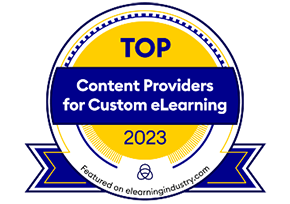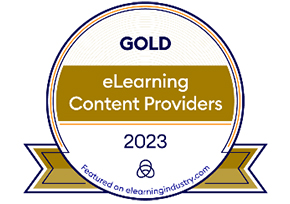Content and Curriculum Design
Solve Your Business Problems with Training Solutions Powered by Robust and Well-designed Curricula

A foolproof way to nail our clients’ requirements is to design the curriculum in such a way that it determines skill gaps and defines strategic goals. While this is a complex process, assessing the effectiveness of training, organization, and integration of learning experiences with the content and ensuring its impact on the learners and business KPIs is even trickier.
Take a look at how we can help you ensure your training investments drive performance gain to address gaps and maximize training ROI by driving measurable business results through our expert Content and Curriculum Design.
What Challenges Does L&D Face When Improving Training Effectiveness and Impact?

Curriculum Design needs to be carefully thought through and involves a lot of strategic decision-making. In most scenarios, the L&D function has more to do, with limited budget, headcount, skillsets, and technology. This makes it incredibly difficult to ensure the business is getting its maximum bang for the buck when it comes to learning.
For the learner, the learning experience is waning, and learner engagement continues to steadily decline. For the organization, learning may not be well aligned with the needs of the business, and it is difficult to measure learning impact. Poor strategy development and alignment, along with an inadequate technology ecosystem means employees are not learning what they need to know to maintain compliance, develop new competencies and skills, and advance their capabilities. This leads to negative outcomes including a lack of innovation and creativity that can make an organization lose its competitive edge.
How Can EI help You Maximize Training Effectiveness, Efficiency, and Its Impact on the Business?
We have a simple, well-grounded yet robust process to design an impactful curriculum that is learner-centric and fully aligns to our clients’ training needs. Here is a snapshot:

Set out with a clear intent – We lay down a clear, well-derived set of goals that helps us build an authentic curriculum that provides a firm foundation on which we build meaningful, world-class learning interventions that meet the learners’ as well as business needs.

Define the pedagogy – After setting up clear goals and a purpose, we define the pedagogy and didactic tone that best suits the learners, aligns with the requirement, and draws itself well to the content.

Drive learner engagement and content enrichment – The next step is to weave in elements that add meaningful learner engagement tied to the goals and also enrich content presentation.

Review and evaluate – Our panel of experts review the impact of the curriculum and its alignment to the requirement and suggest modifications or changes to improve it further.

Determine training impact and ROI – Our measurement model ensures the learning function can demonstrate its impact on the business—and its ROI. We will help you gain more accurate insights on where you should be making future investments, further maximizing the return on investment.
Our Approach in Designing Robust Curricula with Well-crafted Content
We take a trusted consultant’s role while designing content and curricula for our customers. Here is a glimpse of the learner-centered and dynamic approach that EI employs:
During this phase, the learning solution’s goals and objectives are primarily determined. This includes analyzing the target audience, examining the base content, identifying the technology, infrastructure requirements, as well as adhering to various compliance requirements.
This stage involves probing goals and objectives that align with the requirement. These questions help us arrive at goal definitions:
- What is the business need that drives the learning solution?
- What are the key skills/competencies that a learner should acquire?
- What are the critical job requirements and business needs that the solution will help achieve?
This stage involves understanding the target audience well. Questions that bring about clarity into the audience persona and demographic:
- Who is the target audience?
- What are the learners supposed to achieve from the learning solution?
- How much time can they spend on this learning solution?
- What is their level of literacy/expertise?
- Are there any accessibility requirements for the learners?
Analyzing content involves asking questions such as:
- What is the type of content?
- How much content is readily available?
- How much content is ‘Need to Know’ vs ‘Nice to Know’?
- How much of the content is theoretical vs practical?
- How are the learners supposed to use the content?
Besides knowing our audience, content, and objectives, other considerations such as technology and compliance are extremely important for the learning solution to be effectively deployed. This involves asking question such as:
Technology and Infrastructure Availability
- How will the content be delivered?
- What technical infrastructure currently exists in the organization?
- Does the solution need to be device-friendly?
- Is there a need for collaborative/social learning?
Compliance-specific Requirements
- Are there any specific regulatory requirements for the learning solution?
- Does the solution need to follow any compliance standards?
After a thorough analysis, this phase involves selecting the appropriate delivery mechanisms for the curriculum based on the time available for its implementation. This can include WBT, VILT, Blended Learning, Augmented Reality, or Virtual Reality solutions.
The last step involves assessing the level of motivation of the learners and the constraints and challenges they may encounter during the course of the curriculum. As part of this phase, we evaluate the governance mechanisms (organization-driven) to ensure that learners complete the entire curriculum and also formulate the assessment strategy.
- How will the learners be assessed?
- What technology / assessment mechanisms (LMS) are available in the organization?
- Should the assessment be practical/hands-on?
- How will the assessment be evaluated?
- Will there be single or multiple assessments throughout the curriculum?
Our Experience in Designing Relevant and Engaging Curricula
- Gamification
- Microlearning
- Immersive AR/VR solutions
- App-based solutions
- Extended learning journeys
- Learning ecosystems with a combination of different learning modalities
- Sales and Services Trainings
- Banking, Financial Services, and Insurance
- Healthcare, Medical Devices and Pharmaceuticals
- Retail and Consumer Goods
- Government Agencies and Non-Profits
- Manufacturing and Logistics
- Medical Education
- Media and Entertainment
- Airlines, Aviation, and Aerospace
- Beverage and Tobacco
- Automotive Sector

Ranked #1 in eLearning Industry's list of Top Content Providers for Custom eLearning.

Gold Badge for the Top eLearning Content Development Companies.
Case Studies

Empowering New Managers of a Global Banking Giant to Transition to New Responsibilities by Enabling Learning in Their Workflow

How an Automotive Giant Conducted a Virtual Training with 3D Immersive Learning Experiences for a Product Launch
SHARE
Contact us!
Partner with us to futureproof your corporate training.
Read our insights
Get the latest insights, trends, strategies, tips, best practices, guides, and inspiration for improving your training and development programs.
